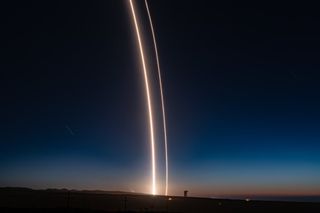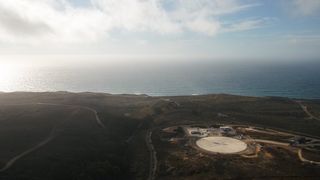SpaceX Aces First-Ever Rocket Landing in California After Spectacular Satellite Launch
SpaceX inaugurated its West Coast rocket-landing pad in style.
A Falcon 9 rocket with a pre-flown first stage launched from California's Vandenberg Air Force Base tonight (Oct. 7) at 10:21 p.m. EDT (7:21 p.m. local time; 0221 GMT on Oct. 8), successfully delivering Argentina's SAOCOM-1A Earth-observation satellite to orbit.
And, less than 8 minutes after liftoff, the booster's first stage came back to Earth for a pinpoint touchdown at SpaceX's Vandenberg landing zone, just a quarter-mile (400 meters) from its launch pad. [See Amazing Photos of SpaceX's SAOCOM-1A Launch]
"This is great news for everyone here at SpaceX," Tom Praderio, a SpaceX firmware engineer, said during live launch commentary tonight. "We're all very excited."
The twilight launch created a spectacular sight in the night sky for spectators in Southern California, who took to Twitter to share their amazing photos. One of those viewers was Los Angeles mayor Eric Garcetti.
"Nope, definitely not aliens," Garcetti wrote on Twitter as he posted an amazing photo. "What you’re looking at is the first launch and landing of the @SpaceX Falcon 9 rocket on the West Coast. The rocket took off from Vandenberg Air Force Base at 7:21 p.m. and landed safely back on Earth."
SpaceX had already pulled off more than two dozen first-stage landings during orbital liftoffs, with the boosters coming down on robotic "drone ships" stationed in the Atlantic and Pacific oceans and on terra firma at Cape Canaveral Air Force Station in Florida. But tonight's event marked SpaceX's first-ever land touchdown on the West Coast.
Get the Space.com Newsletter
Breaking space news, the latest updates on rocket launches, skywatching events and more!
Such landings are part of SpaceX's push to develop fully and rapidly reusable rockets and spacecraft, a breakthrough that company founder and CEO Elon Musk has stressed could cut the cost of spaceflight enough to make grand exploration feats such as the settlement of Mars economically feasible.
In keeping with that vision, tonight marked the second flight for this particular Falcon 9 first stage, which also helped loft 10 Iridium Next commercial communications satellites from Vandenberg on July 25.

By the way: SpaceX would like to land every booster on terra firma, to ease the reflight process. But that's possible only when launching relatively light payloads to not-too-distant orbits; on other missions, there's not enough fuel left for the Falcon 9 first stage to maneuver all the way back to land.
SpaceX calls its California touchdown site Landing Zone 4, presumably because it's part of Vandenberg's Space Launch Complex 4 (SLC-4). This facility, which SpaceX leases from the Air Force, used to feature two launch pads, known as SLC-4 East and SLC-4 West. SpaceX has converted the western one into a landing site and launches Falcon 9s from the eastern one. (The company has two touchdown sites at Cape Canaveral, which are called Landing Zone 1 and Landing Zone 2.)

The 3,500-lb. (1,600 kilograms) SAOCOM-1A satellite was developed by Argentina's national space agency, which is known by its Spanish acronym CONAE. The spacecraft will set up shop 385 miles (620 kilometers) above Earth and scrutinize the planet using a Synthetic Aperture Radar (SAR) instrument.
SAOCOM-1A's radar measurements will track soil-moisture levels, thereby aiding forecasts of crop yields. The mission will also help planners and emergency-management officials keep tabs on wildfires, floods and other disasters.
The satellite's twin, SAOCOM-1B, will also launch on a Falcon 9; its liftoff is targeted for next year. Both spacecraft will make similar observations from orbit, which will be integrated with measurements made by a network of Italian satellites.
"SAOCOM-1, together with the Italian COSMO-SkyMed X-Band SAR constellation, comprise the Italian-Argentine Satellite System for Emergency Management (SIASGE), a partnership between CONAE and the Italian Space Agency (ASI)," SpaceX officials wrote in a mission description. "Flying both constellations along the same orbit supports a rapid response by providing SAR information in emergency situations."
"SAOCOM" is short for "Satélite Argentino de Observación Con Microondas," which is Spanish for "Argentine Microwave-Observation Satellite."
Editor's note: If you captured an amazing photo of video of SpaceX's Falcon 9 rocket launch and would like to share it with Space.com for a story or gallery, send images and comments in to: spacephotos@space.com.
Mike Wall's book about the search for alien life, "Out There,"will be published on Nov. 13. Follow him on Twitter @michaeldwall and Google+. Follow us @Spacedotcom, Facebook or Google+. Originally published on Space.com.
Join our Space Forums to keep talking space on the latest missions, night sky and more! And if you have a news tip, correction or comment, let us know at: community@space.com.

Michael Wall is a Senior Space Writer with Space.com and joined the team in 2010. He primarily covers exoplanets, spaceflight and military space, but has been known to dabble in the space art beat. His book about the search for alien life, "Out There," was published on Nov. 13, 2018. Before becoming a science writer, Michael worked as a herpetologist and wildlife biologist. He has a Ph.D. in evolutionary biology from the University of Sydney, Australia, a bachelor's degree from the University of Arizona, and a graduate certificate in science writing from the University of California, Santa Cruz. To find out what his latest project is, you can follow Michael on Twitter.